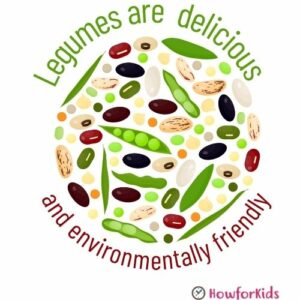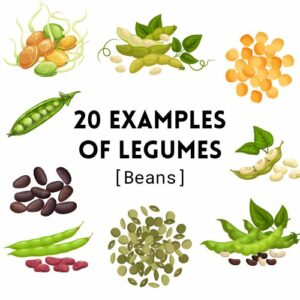Legumes are a diverse group of dicotyledonous plants, both cultivated and wild. Their defining characteristic is the formation of pods as fruits, which contain the seeds. When ripe, these fruits split open lengthwise into two valves, allowing the seeds to disperse. However, there are species with fruits that do not open easily.

In some cases, the entire pod is consumed, as with green beans. Other times, the seeds are extracted and consumed as grains, such as beans, soybeans, lentils, chickpeas, peas, and peanuts. Some legumes, like alfalfa or clover, are commonly used as fodder for livestock. Additionally, these legumes attract bees and contribute to honey production.
Leguminous trees are primarily found in tropical regions, where they can grow to large sizes. Examples include tipas, ceibos, and white carobs, some of which have valuable wood.
There are over 700 genera and nearly 20,000 species of legumes worldwide.

Why Are Legumes Important?
Table of Contents
Legumes are an excellent source of nutrients and are known for their health benefits due to their content of proteins, fiber, vitamins, and minerals.
Legumes possess a unique characteristic of developing special structures called nodules on their roots. These nodules form through a symbiotic relationship between the plants and certain bacteria, allowing the plants to fix atmospheric nitrogen.
As a result, legumes contribute to soil fertility by incorporating nitrogen into the soil. This is why many pastures include leguminous species. In addition to their agricultural significance, many legume flowers exhibit striking shapes and colors, such as the vibrant yellow broom or the ceibo with its red flowers.
One particular leguminous plant is commonly known as the sensitive mimosa, shameful plant, or simply mimosa. Its scientific name is Mimosa pudica. This legume has the remarkable ability to respond to touch by rapidly folding its leaves and branches.
It is believed that this behavior serves as a defense mechanism, making the plant appear withered and unattractive to insects and other predators.

Examples of Legumes
Here are some examples of legume species:

- Tipa
- Bean
- Soybean
- Ceibo
- Pea
- Carob
- Lentil
- Tamarind
- Peanut
- Brazilwood
- Lupine
- Robinia pseudoacacia
- Alfalfa
- Sophora
- Clover
- Black Ear
- Chickpea
- Bahuinia candicans
- Acacia
- Astragalus

Fun Facts About Legumes
- Legumes have been cultivated and consumed by humans for thousands of years, with evidence of their use dating back to ancient civilizations such as the Aztecs and Egyptians.
- The largest legume crop in the world is the soybean, which is a versatile ingredient used in a wide range of food products, from tofu and soy milk to soy sauce and vegetable oil.
- Legumes come in a variety of colors, shapes, and sizes. From the vibrant red of kidney beans to the speckled patterns on chickpeas, legumes add visual appeal to dishes.
- Some legumes, like peanuts, are technically not nuts but rather belong to the legume family. So, the next time you enjoy peanut butter, you can impress your friends with this fun fact!
- The term “Three Sisters” refers to the traditional Native American agricultural practice of planting corn, beans, and squash together. This symbiotic planting method maximizes space, enhances soil fertility, and provides a balanced diet.
- In some cultures, eating lentils on New Year’s Day is believed to bring good luck and prosperity for the coming year.
- Legumes are not only nutritious for humans but also benefit the environment. Through nitrogen fixation, they improve soil quality and reduce the need for synthetic fertilizers, making them a sustainable choice for farmers.
- The world’s largest lentil dish was prepared in India in 2019, weighing a whopping 4,700 kilograms (10,360 pounds)!
- Legumes are versatile ingredients that can be used to create a variety of meat alternatives, such as veggie burgers, falafel, and plant-based sausages.
- Some legumes, like the sensitive mimosa (Mimosa pudica), exhibit unique behaviors. When touched, their leaves and branches quickly fold up, earning them names like “shy plant” or “touch-me-not.”
- Legumes have been associated with longevity. In regions known as Blue Zones, where people live exceptionally long lives, legumes are a staple in their diets.
- Chickpea flour, also known as gram flour or besan, is commonly used in gluten-free baking and as a thickening agent in soups, sauces, and batters.
- The world record for the tallest sunflower was set in 2014, measuring 9.17 meters (30 feet, 1 inch). Sunflowers belong to the family Asteraceae, but their seeds are classified as legumes.
- In addition to their nutritional value, legumes are cost-effective compared to many other protein sources, making them an accessible and affordable option for people around the world.
- Legumes are not only delicious but also environmentally friendly. Their cultivation requires significantly less water compared to animal farming, making them a sustainable choice for reducing water usage.

So, whether you’re enjoying a bowl of lentil soup or snacking on roasted chickpeas, you can appreciate the fascinating and fun facts behind these versatile and beneficial legumes!